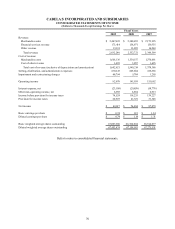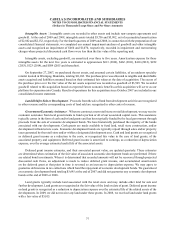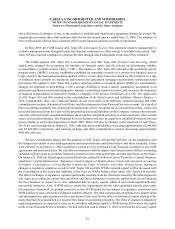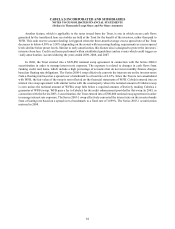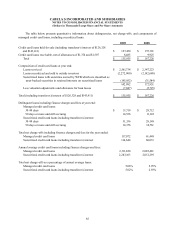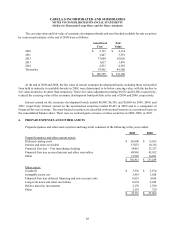Cabela's 2009 Annual Report Download - page 88
Download and view the complete annual report
Please find page 88 of the 2009 Cabela's annual report below. You can navigate through the pages in the report by either clicking on the pages listed below, or by using the keyword search tool below to find specific information within the annual report.79
CABELA’S INCORPORATED AND SUBSIDIARIES
NOTES TO CONSOLIDATED FINANCIAL STATEMENTS
(Dollars in Thousands Except Share and Per Share Amounts)
as of January 1, 2006, we estimated compensation expense based on the grant date fair value estimated under the
provisions of APB Opinion No. 25. Costs associated with all awards are included in compensation expense as a
component of selling, distribution, and administrative expenses.
Financial Instruments and Credit Risk Concentrations – Financial instruments which may subject us to
concentrations of credit risk are primarily cash, cash investments, and accounts receivable. We invest primarily in
money market accounts or tax-free municipal bonds, with short-term maturities, limiting the amount of credit exposure
to any one entity. At January 2, 2010, we had approximately $326,855 in cash invested in overnight funds at two major
financial institutions, along with $184,010 in cash invested in a money market mutual fund at another major financial
institution. Concentrations of credit risk on accounts receivable are limited due to the nature of our receivables.
Fair Value of Financial Instruments – The carrying amount of cash and cash equivalents, accounts receivable,
accounts payable, gift certificates (including credit card loyalty rewards programs), accrued expenses, short-term
borrowings, and income taxes payable included in the consolidated balance sheets approximate fair value given the
short-term nature of these financial instruments. The estimated fair values of our long-term debt instruments are
based on the amount of future cash flows associated with each instrument discounted using current borrowing rates
for similar debt instruments of comparable maturity.
Derivatives – We use derivatives for the purpose of hedging our exposure to changes in interest rates and foreign
currency exchange rates. The fair value of each derivative is recognized in the consolidated balance sheets within
current assets or current liabilities. For derivatives designated as a hedge and used to hedge an anticipated transaction,
changes in the fair value of the derivatives are deferred in the consolidated balance sheets within accumulated other
comprehensive income (loss) to the extent the hedge is effective in mitigating the exposure to the related anticipated
transaction. Any ineffectiveness associated with the hedge is recognized immediately in earnings. Amounts deferred
within accumulated other comprehensive income (loss) are recognized in the consolidated income statements in
the same period during which the hedged transaction affects earnings. For derivatives that do not qualify for hedge
accounting, changes in fair values are recognized immediately in earnings.
Comprehensive Income (Loss) – Comprehensive income (loss) consists of net income, derivative adjustments,
unrealized gains and losses on available-for-sale economic development bonds and asset-backed available-for-sale
securities, and foreign currency translation adjustments, net of related income taxes.
Currency Translation – Assets and liabilities of our Canadian operations are translated into U. S. dollars at
currency exchange rates in effect at the end of a reporting period. Gains and losses from translation into U. S. dollars
are included in accumulated other comprehensive income (loss) in our consolidated balance sheets. Revenues and
expenses are translated at average monthly currency exchange rates.
Earnings Per Share – Basic earnings per share (“EPS”) is computed by dividing net income by the weighted
average number of shares of common stock outstanding during the period. Diluted EPS is computed by dividing net
income by the sum of the weighted average number of shares outstanding plus all additional common shares that
would have been outstanding if potentially dilutive common share equivalents had been issued.
2. ACCOUNTING PRONOUNCEMENTS
Effective December 30, 2007, we adopted the provisions of ASC Topic 820, Fair Value Measurements and
Disclosures. This statement defines fair value, establishes a hierarchal disclosure framework for measuring fair
value, and requires expanded disclosures about fair value measurements. The provisions of this statement apply to
all financial instruments that are being measured and reported on a fair value basis. The partial adoption of ASC
Topic 820 did not have any impact on our financial position or results of operations. Effective December 28, 2008,
we adopted the remaining provisions of ASC Topic 820 that were delayed by the issuance of ASC Section 820-10-55,



